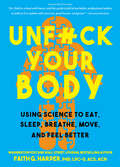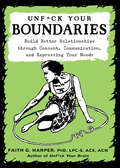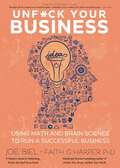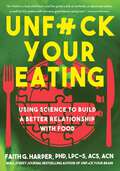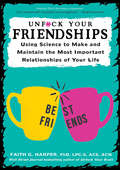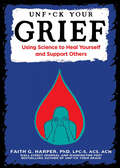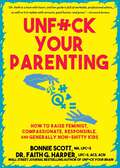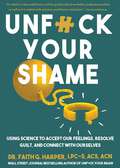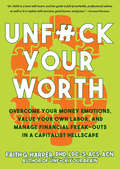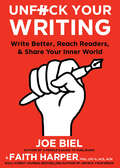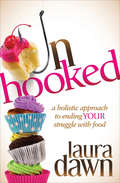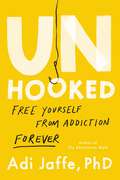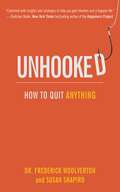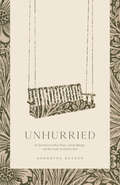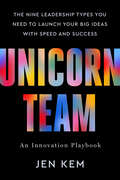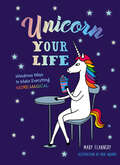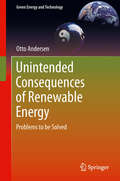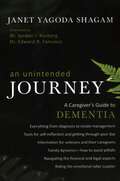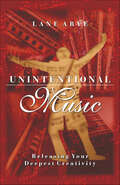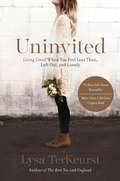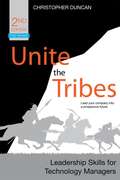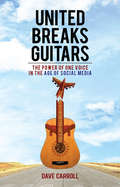- Table View
- List View
Unfuck Your Body: Using Science to Reconnect Your Body and Mind to Eat, Sleep, Breathe, Move, and Feel Better
by Faith G. Harper, PhD, LPC-S, ACS, ACNIs your body an asshole? Does it keep you up at night, crave nonstop French fries and ice cream, and try to convince you that exercise is evil? Does it develop weird illnesses and pains for no apparent reason and run out of energy just when you need it the most? Does having a body at all fill you with uncomfortable emotions? Enter Dr. Faith G. Harper, therapist, nutritionist, and bestselling author of Unfuck Your Brain. She explains the emerging science of the gut-brain connection and the vagus nerve so that everyone can understand what's going on in your body and how to make friends with it again, especially if you've experienced trauma or chronic stress. Filled with straight talk and practical exercises so you can reconnect with your physical needs and reactions, work through body shame, manage illness and disability, and implement small changes that make a huge difference in how you feel every day. You are a whole person and it's time to reconnect with yourself!
Unfuck Your Boundaries: Build Better Relationships through Consent, Communication, and Expressing Your Needs (5-minute Therapy Ser.)
by Faith G. Harper, PhD, LPC-S, ACS, ACNBoundaries are the ways we communicate our needs. They are what allow us to feel safe among strangers, in everyday interactions, and in our closest relationships. When we have healthy boundaries, we have a strong foundation in an uncertain world. And when someone crosses your boundaries, or you cross someone else's, the results range from unsettling to catastrophic. In this book, bestselling author Dr. Faith Harper offers a full understanding of issues of boundaries and consent, how we can communicate and listen more effectively, and how to survive and move on from situations where our boundaries are violated. Along the way, you'll learn when and how to effectively say "no" (and "yes"), troubleshoot conflict, recognize abuse, and respect your own and others' boundaries like a pro. You'll be amazed at how much these skills improve your relationships with friends, strangers, coworkers, and loved ones.
Unfuck Your Brain: Using Science to Get Over Anxiety, Depression, Anger, Freak-outs, and Triggers (Five Minute Therapy #1)
by Faith G. Harper, PhD, LPC-S, ACS, ACNOur brains are doing our best to help us out, but they can be real assholes sometimes. Sometimes it seems like your own brain is out to get you—melting down in the middle of the grocery store, picking fights with your date, getting you addicted to something, or shutting down completely at the worst possible moments. You already told your brain firmly that it isn't good to do these things. But your brain has a mind of its own. That's where this book comes in. With humor, patience, and lots of swearing, Dr. Faith shows you the science behind what's going on in your skull and talks you through the process of retraining your brain to respond appropriately to the non-emergencies of everyday life. If you're working to deal with old traumas, or if you just want to have a more measured and chill response to situations you face all the time, this book can help you put the pieces of the puzzle together and get your life and brain back.Here's an excerpt from the book:Knowing what&’s going on up in your brain is HUGE. So much of how we interact with the world around us is a completely normal response when we take into account our past experiences and how our brains work. • Freaking the fuck out • Avoiding important shit we need to take care of • Feeling pissed off all the time • Being a dick to people we care about • Putting shit in our bodies that we know isn&’t good for us • Doing shit we know is dumb or pointlessNone of these things are fucking helpful. But they all make sense.Your brain has adapted to the circumstances in your life and started doing things to protect you, bless it. It&’s not TRYING to fuck you over (even though it totally is, at times).As we navigate the world, nasty shit happens. The brain stores info about the nasty shit to try to avoid it in the future. Sometimes these responses are helpful. Sometimes the responses become a bigger problem than the actual problem was. It&’s called a trauma reaction.And even if you aren&’t dealing with a specific trauma? Adaptive coping strategies, bad habits, and funky behaviors all wire in similar ways. And research is showing that these issues are actually some of the easier ones to treat in therapy … if we address what&’s really going on, rather than just the symptoms.
Unfuck Your Business: Using Math and Brain Science to Run a Successful Business
by Joe Biel Dr Faith G. HarperHow do you start and run a successful business, despite the odds? This unique guide to entrepreneurship teaches you practical math and management skills alongside the emotional intelligence, self-awareness, and coping skills that you need in order to overcome internal barriers to success no matter what type of business you are in. Joe Biel, author of A People's Guide to Publishing, draws on 26 years of business ownership and management experience to walk you through how to think like a business owner, plan, strategize, manage budgets, scale up, and keep your focus on what's most important.Dr. Faith Harper, author of the bestselling Unfuck Your Brain, provides vital skills that aren't often lauded in business books, such as overcoming imposter syndrome and other fears, communicating your boundaries, building mutually beneficial relationships, and preventing your emotional baggage from becoming your biggest business pitfall.If you've ever dreamed of starting a small business, or if you currently run a business and want to strengthen it for long term success, this practical guide cuts through the jargon and teaches you the skills you need to enjoy facing the challenges and surprises every day in business brings.
Unfuck Your Eating: Using Science to Build a Better Relationship with Food, Health, and Body Image
by Dr Faith G. HarperFood is complicated. And our relationships with food and eating are all kinds of fucked up. It doesn't help that cultural messages about health, diet, body image, and weight are fatphobic and often medically dangerous. Dr. Faith Harper, author of the bestselling Unfuck Your Brain and Unfuck Your Body, brings her trademark combination of science, humor, and real talk to help us work through our food, health, and body image issues and develop a healthier relationship with food so that it can fuel us and bring us pleasure. She delves into the difference between eating disorders and disordered eating and the causes and consequences of both, breaks down the difference between various behaviors, tackles trauma and other co-occurring conditions, and provides compassionate and practical steps to improve your eating habits and repair your relationship with yourself.
Unfuck Your Friendships: Using Science to Make and Maintain the Most Important Relationships of Your Life
by Faith G. HarperFriendship deserves more credit in a society obsessed with romantic and sexual relationships. In reality, friendship is the key to our mental and physical health, happiness, and social cohesion. Dr. Faith Harper, therapist and bestselling author of Unfuck Your Intimacy and Unfuck Your Boundaries applies brain science and her clinical and personal experience to help understand this vital type of relationship, offering insight into how to choose and make friends, sustaining and strengthening your friendships, friend group dynamics, friend breakups, setting excellent friendship boundaries, handling conflict, and managing all the different kinds of relationships we encounter in our lives. Includes a series of original advice columns honing in on the details that make our friendships work.
Unfuck Your Grief: Using Science to Heal Yourself and Support Others
by Dr Faith G. HarperWhen we lose someone or something close to us—a loved person or animal, a relationship, our health, our dream, our idea of who we are—it hurts. A lot. Grief is both what we experience and how we heal. Dr. Faith Harper, bestselling author of books like Unfuck Your Brain and Unfuck Your Boundaries brings us a counseling and neuroscience perspective on grieving. She explains what is actually happening in our brains and bodies and what we need in order to allow it to happen fully. She also shows us how to identify and treat traumatic grief, the variety of grieving processes we experience, what grief looks like in the long term, when to get professional support, and how to ask the people in our lives for what we need (and to give ourselves the care we need as well). You'll also find solid advice on how (and how not!) to support a grieving person in your life. Wise, a little crass, and gently funny.
Unfuck Your Parenting: How to Raise Feminist, Compassionate, Responsible, and Generally Non-Shitty Kids
by Bonnie Scott Dr Faith G. HarperHow do you raise your kids to be functional adults with big hearts? Young people need to learn to stand up against every kind of oppression, respect boundaries and consent, and gain self-compassion while also navigating money, friends, sex, and school. How can you prepare children and teens to find joy and stability as they cope with uncertainty, violence, and disaster, especially when your own coming-of-age lessons weren't so thoughtfully taught?Parents and mental-health professionals Dr. Faith G. Harper and Bonnie Scott have written a parenting guide for the 21st century that is a must-read for people with children of any age, from infancy to adulthood. Drawing from their experiences raising diverse, politically active young people, this book will help you bring up a new generation with tools to change the world for the better—all while maintaining your own separate identity and relationships, and without losing your mind.
Unfuck Your Shame: Using Science to Accept Our Feelings, Resolve Guilt, and Connect with Ourselves
by Dr Faith G. HarperShame and guilt are perhaps the most difficult emotions humans experience. They tell us we are fundamentally broken, wrong, and unsalvageable—and then we operate in the world from that self-concept. Dr. Faith G. Harper, bestselling author of Unfuck Your Brain and Unfuck Your Stress, writes that these emotions often result from our sense of "not-enough-ness" and the overwhelming feeling that we need to hide parts of ourselves in order to be loved and accepted. But we don't need to keep going through life feeling guilty, ashamed, and disconnected from ourselves. With compassion, humor, brain science, and swearing, she guides us through the difficult shadow work of finding and reconnecting with these hidden parts and learning to accept our whole selves to regain our sense of vitality and completeness. Because we each deserve the experience of being a fully alive human.
Unfuck Your Worth: Overcome Your Money Emotions, Value Your Own Labor, and Manage Financial Freak-outs in a Capitalist Hellscape
by Faith G. Harper, PhD, LPC-S, ACS, ACNUntangle your emotions and expectations about money so that you can live your best financial life. Without fear and shame holding you back, it's more possible to move past all those social barriers to actualizing whatever your money aspirations are, whether that's getting a raise, getting out of debt, having honest conversations about money with your family, raising your kids to be savers, or wherever your values lead you. Dr. Faith, author of the bestselling Unf*ck Your Brain and Unf*ck Your Intimacy, tackles one of the toughest emotional topics there is with her trademark mix of neuroscience, gentle encouragement, and no-nonsense language. This book isn't about getting rich quick (or necessarily at all)—it's about figuring out your own economic values and baggage, and learning to be the person in the world you know you have it in you to be.
Unfuck Your Writing: Write Better, Reach Readers, & Share Your Inner World
by Joe Biel Faith G. Harper, PhD, LPC-S, ACS, ACNWant to be a writer, but the words won't come? Do you have a lot to say but don't know how to write it so people will read it? Do you struggle with anxiety, procrastination, or feeling like an imposter around your writing? Microcosm's two most prolific authors teach you their tricks of the trade in this no-nonsense, practical guide to the craft of writing longform work. Learn skills like setting and sticking to goals, communicating effectively with your writing, having fun while writing, working with an editor, and creating reader-oriented work. This is not a book about crafting beautiful sentences with perfect grammar; instead Harper and Biel will teach you to write so that your words have the greatest possible impact on the world.
Unhitched: Unlock Your Courage and Clarity to Unstick Your Bad Marriage
by Sunny Joy McMillanUnhitched: Unlock Your Courage and Clarity and Unstick Your Bad Marriage is a heart-centered, yet practical guide for helping women in unhappy marriages answer the question of whether to stay or go.Unhitched tracks Sunny Joy McMillan&’s own journey, from once living a seemingly perfect life on paper but really hiding an unhappy and high-conflict marriage, all the way to a loving, post-divorce friendship with her ex-husband. Demonstrated through both her own story and case studies from her clients, Sunny&’s guide outlines a clear process for answering the question of whether to stay or go, shows women how to get divorced gracefully should they decide to leave, and tells women how to create a better, new life.Unhitched provides women with the clarity to make the right decisions for their marriage, courage to take the right action, and confidence that their life can be better on the other side. Although this guide is practical and includes many tangible exercises and tools, it is unlike similarly-themed guides in that it takes a less sterile and more heart-centered, spiritually-based approach to making tough decisions and taking tough action in a marriage.
Unhooked: A Holistic Approach to Ending Your Struggle with Food
by Laura DawnBreak unhealthy food habits with these practical steps that combat the mental and emotional factors keeping us hooked, unhappy, and overweight. Our relationship with food extends far beyond survival. It incorporates aspects of physiology, emotions, thought patterns, and how we feel about ourselves—all influenced by a culture that turns food into a source of compulsion and guilt. Despite our best efforts, many of us remain hooked to unhealthy food habits—habits that keep us overweight and unhappy. In Unhooked, Laura Dawn sheds light on the food struggle from six essential perspectives: environmental, physiological, behavioral, mental, emotional, and spiritual. And she provides concrete steps you can take to free yourself from your personal food traps—whether it&’s chronic overeating, incessant cravings, food addiction, yo-yo dieting, disordered eating, or the inability to eat certain foods in moderation. These steps empower us to shift our perspective on food, fueling our transformation to vibrant health and reminding us that we are all worthy of living the healthy lives of our dreams.
Unhooked: Free Yourself from Addiction Forever
by Adi JaffeLearn to identify the "hooks" that trigger your addictive behavior and replace compulsive habits with constructive ones using this helpful guide from a mental health expert. As a young man, Dr. Adi Jaffe&’s own battle with addiction nearly landed him a decades-long prison sentence. Now, his revelatory addiction treatment protocol has helped thousands to free themselves from the addictive habits that cause negative consequences. Dr. Jaffe&’s shame-free, step-by-step program helps you address what's driving your addiction by: ·Identifying the &“hooks&” that drive your behavior ·Building awareness of when these hooks are activated ·Unpacking your go-to habitual responses ·Creating new, healthier patterns and ways of reactingThe Unhooked Method destigmatizes addiction and uses habit change knowledge and tools to help you to unhook for an addiction-free life.
Unhooked: How to Quit Anything
by Susan Shapiro Frederick WoolvertonIs smoking, alcohol, drugs, food, gambling, the Internet, or sex addiction holding you back from getting what you want most-in work and in love? We're all addicted to something-but when the crutch gets in the way of living a happy and productive life, it must stop. Over the past twenty-five years, renowned addiction therapist Dr. Frederick Woolverton has used his dynamic, empathetic approach to help thousands of addicts achieve long-term recovery-including himself. He sees the specific habit as less important than the underlying chaos and fear that motivate the urge to sooth ourselves with bad habits. The solution, he has found, requires only a better understanding of yourself and a change in attitude. Unhooked: How To Quit Anything is an intelligent, readable, and actionable guide to conquering any addictive habit. Using real patient examples as well as research and his own experience, Dr. Woolverton and coauthor (and former patient) Susan Shapiro show how to thrive without self-medicating. The approach involves an unorthodox blend of straightforward changes to behavior and open and honest conversation with another person. Woolverton's specific instructions do not require an expensive therapist, rehab, 12-step program, or a higher power (but he does make readers aware of those viable options). Let him help you kick your addiction and find what's missing in your world. When you conquer a toxic habit, you are leaving room for something more beautiful to take its place.
Unhurried: An Invitation to Slow Down, Create Margin, and Surrender Control to God
by Samantha DeckerExperience the joy of slowing down, creating margin, and surrendering control to God.Samantha Decker lived a hurried life. Swimming in chaos with a never-ending to-do list, she experienced the fatigue and desperation of rushing from one thing to another. But, amidst her chaos and fruitless efforts to do and be everything, the Lord gently met her. He invited her to slow down and experience His created design for rest.In Unhurried, we will explore our busy, hurried lives and discover how we can experience the joy of slowing down. We will learn more about margin—what is it, how did Jesus create it, and how can we follow Him? Through the Lord&’s guidance and grace, Samantha also shows us how to make time for eternal realities.Are your days marked by busyness, striving, and planning?Does rest feel unattainable?Do you regularly describe yourself as &“busy&”?This book is an invitation to rest, create space, and join God in the work He&’s doing.This is the story of a God who knows how to rest. A God who has everything under control. A God who gave His only Son to save us from our sins and the bondage they bring. In Christ, there is freedom from striving, busyness, and hurry. Are you ready to take off these weights and follow Jesus?
Unicorn Team: The Nine Leadership Types You Need to Launch Your Big Ideas with Speed and Success
by Jen KemUnlock the secrets to building a values-driven Unicorn Team and revolutionize your leadership approach!You are a Unicorn. You are inspiring, innovative, and powerful—and your idea has the potential to be the next big thing. But whether it&’s a product, a service, or a brilliant upgrade that your company could make, you need the right team to make it happen.Renowned brand strategist and entrepreneur Jen Kem will show you how to identify your Unicorn Leadership Type so that you can build and lead the most collaborative, harmonious, and motivated team of Unicorns to achieve extraordinary results. This values-driven approach to vision, strategy, and mobilization will revolutionize your company culture, enhance employee satisfaction, and drive organizational growth.This indispensable guide reveals:The Unicorn Innovation Model™: Pick the best idea to pursue, rally the right people, and make it rapidly happenThe 9 types of Unicorns: Discover your leadership style and who your team needs to complement each otherHow to achieve Unicorn Energy™: Reach the flow state where your team works together fluidly, confidently, and successfullyHuman beings make the difference between an idea that goes nowhere and an idea that changes the world. Are you ready to turn your great idea into concrete reality?
Unicorn Your Life: Wondrous Ways to Make Everything More Magical
by Mary FlanneryFind your &“unicorn magic&” with this fun self-help guide—and make your world more wonderful! It&’s the little things we do for ourselves that make our day brighter . . . just like a unicorn&’s horns make it enchanting and different from anything else. Unicorn Your Life helps you discover your own brand of magic—whether it&’s a tasty treat, fresh flowers, or your favorite sparkly shoes—and assure you get more of it. This playful, mindful guide has quizzes, suggestions for creating perfect &“unicorn spaces&” at home and work, ideas for nurturing the positive relationships in your life, and strategies for unleashing the self-assured, confident creature that lives inside you!
Unintended Consequences of Renewable Energy
by Otto AndersenEnergy technologies in the future will need to be based on renewable sources of energy and will, ultimately, need to be sustainable. This book provides insight into unintended, negative impacts and how they can be avoided. In order to steer away from the pitfalls and unintended effects, it is essential that the necessary knowledge is available to the developers and decision makers engaged in renewable energy. The value of this book lies in its presentation of the unintended health and environmental impacts from renewable energies. The book presents results from cross-disciplinary research on the implementation of alternative fuels in the transport sector, namely hydrogen, electricity and biodiesel. This is followed by an assessment of environmental impacts from the production of solar cells. Critical reviews on the use of nanotechnology and nanomaterials in the energy technologies is then provided, with the formation of nanoparticles during combustion of bio-blended diesel and their toxic effects, discussed in detail.
Unintended Journey: A Caregiver's Guide to Dementia
by Janet Yagoda Shagam*New Edition with Updated dementia, dementia care, and resource information.*According to the Alzheimer&’s Association, there are more than six million people living in the United States have Alzheimer's disease or some other form of dementia. Not reported in these statistics are the sixteen million family caregivers who, in total, contribute nineteen billion hours of unpaid care each year. This book addresses the needs and challenges faced by adult children and other family members who are scrambling to make sense of what is happening to themselves and the loved ones in their care. The author, an experienced medical and science writer known for her ability to clearly explain complex and emotionally sensitive topics, is also a former family caregiver herself. Using both personal narrative and well-researched, expert-verified content, she guides readers through the often-confusing and challenging world of dementia care. She carefully escorts caregivers through the basics of dementia as a brain disorder, its accompanying behaviors, the procedures used to diagnose and stage the disease, and the legal aspects of providing care for an adult who is no longer competent. She also covers topics not usually included in other books on dementia: family dynamics, caregiver burnout, elder abuse, incontinence, finances and paying for care, the challenges same-sex families face, and coping with the eventuality of death and estate management. Each chapter begins with a real-life vignette taken from the author's personal experience and concludes with "Frequently Asked Questions" and "Worksheets" sections. The FAQs tackle specific issues and situations that often make caregiving such a challenge. The worksheets are a tool to help readers organize, evaluate, and self-reflect. A glossary of terms, an appendix, and references for further reading give readers a command of the vocabulary clinicians use and access to valuable resources.
Unintentional Music: Releasing Your Deepest Creativity
by Lane AryeThe last time you whistled a tune or hummed a song-why did you choose that one? You may not consider yourself a musical person, but your little act of unintended music may be the key to unlocking within you a wealth of unsuspected creativity-a kind of creativity that goes way beyond music, too.Lane Arye, PhD, a musician himself, focuses on the music that people do not intend to make. Using the highly regarded psychological model called Process Work, developed by Arnold Mindell, PhD, Arye has been teaching students around the world how to awaken their creativity, using music as the starting point, but including all art forms and ways of expression.The unintentional appears at moments when some hidden part of us, something beyond our usual awareness, suddenly tries to express itself. If we start paying attention to what is trying to happen rather than to what we think should happen, we open the door to self-discovery and creativity. Sometimes what we regard as "mistakes" in self-expression are in fact treasures.The book is rich with real-life stories, ideas, and practical techniques for unlocking creativity, which Arye dispenses with humor, insight, and enthusiasm.
Uninvited: Living Loved When You Feel Less Than, Left Out, and Lonely
by Lysa TerkeurstThe enemy wants us to feel rejected . . . left out, lonely, and less than. When we allow him to speak lies through our rejection, he pickpockets our purpose. Cripples our courage. Dismantles our dreams. And blinds us to the beauty of Christ's powerful love. In Uninvited, Lysa shares her own deeply personal experiences with rejection--from the incredibly painful childhood abandonment by her father to the perceived judgment of the perfectly toned woman one elliptical over. With biblical depth, gut-honest vulnerability, and refreshing wit, Lysa helps readers: Release the desire to fall apart or control the actions of others by embracing God-honoring ways to process their hurt. Know exactly what to pray for the next ten days to steady their soul and restore their confidence. Overcome the two core fears that feed our insecurities by understanding the secret of belonging. Stop feeling left out and start believing that "set apart" does not mean "set aside." End the cycle of perceived rejection by refusing to turn a small incident into a full blown issue.
Unite The Tribes
by Christopher DuncanEvery day, customers see the results of companies where fiefdoms have formed and silos create divisional or departmental strife: poor sales and profits, and lackluster products. It's not hard to see that such companies are headed for an early grave. Regardless of the manner in which company fractures manifest themselves, tech leaders must find a way to rid their workplaces of the divisions that threaten to undermine their company's productivity, profits, and survival. That's why, in Unite the Tribes: Leadership Skills for Technology Managers, Christopher Duncan, bestselling author of The Career Programmer, provides corporate leaders with a ten-point plan for joining their company's divided ranks together in a way that helps employees achieve their goals while also accomplishing those of the company. Using the metaphors of the company as empire and the groups that form within companies as tribes, Duncan explains that the formation of tribes within an empire is unavoidable. After all, regardless of the situation in which they find themselves, human beings are social creatures who align themselves with those whose goals and motivations match their own. That's why the accountants hang together in the break room, while developers talk shop and geek culture in a watering hole down the street. Yet the job of leaders is to build a cohesive, powerful, and enduring empire by bringing all groups together in service to a shared, inspiring mission. And that goes double for tech companies, where breakthroughs create new landscapes on a daily basis. In Unite the Tribes, you will learn: How to build alliances and a spirit of unity across all levels of the company to achieve higher employee morale, greater profits, and increased productivity. How to come up with strategies that win market share as well as the hearts and minds of your employees. How to manage conflict. Why self-interest rules the day and how knowing another's wants and needs helps you achieve goals of your own. Unite the Tribes will show you, the visionary leader, how to establish an empire by convincing your tribes of a simple but crucial truth: Alone, you are weak and vulnerable. United, you are invincible. What you'll learn Readers of Unite the Tribes will learn: Practical, down-to-earth approaches to problem solving and productivity that make sense to corporate leaders who have to do real work in the real world. How to arrive at a plan for uniting the disparate groups that operate within their company when faced with the daily reality of office politics, maneuvering, ambition, incompetence, and short-term thinking. How to convey the company's purpose to employees in a way that is realistic and meaningful so that all workers can contribute to the company's greater good. Who this book is for Those serving in leadership or managerial capacities (i. e. , those overseeing one or more employees) at technology companies plagued with division and dysfunction will find the solutions they need to rally their employees to join forces in Unite the Tribes. In addition, leaders and managers of companies whose cohesion is still healthy yet is being threatened with fracture will be provided with real-world strategies for reinforcing the glue that holds their company together in this practical, applications-driven guide. Table of Contents The Myth of Absolute Power Building the Future A Lasting Empire Vision Leadership Organization Mobility Competitiveness Persuasion Strategy Brilliance Morale Unite
United Breaks Guitars: The Power Of One Voice In The Age Of Social Media
by Dave CarrollSongwriter Dave Carroll wasn’t the first person abused by an airline’s customer service. But he was the first to show how one person, armed with creativity, some friends, $150, and the Internet, could turn an entire industry upside down. United Airlines had broken Dave’s guitar in checked luggage. After eight months of pestering the company for compensation, he turned to his best tool—songwriting—and vowed to create a YouTube video about the incident that he hoped would garner a million views in one year. Four days after its launching, the first million people had watched "United Breaks Guitars." United stock went down 10 percent, shedding $180 million in value; Dave appeared on outlets as diverse as CNN and The View. United relented. And throughout the business world, people began to realize that "efficient" but inhuman customer-service policies had an unseen cost—brand destruction by frustrated, creative, and socially connected customers. "United Breaks Guitars" has become a textbook example of the new relationship between companies and their customers, and has demonstrated the power of one voice in the age of social media. It has become a benchmark in the customer-service and music industries, as well as branding and social-media circles. Today, more than 150 million people are familiar with this story. In this book, you’ll hear about how Dave developed the "just do it" philosophy that made him the ideal man to take on a big corporation, what it felt like to be in the center of the media frenzy, and how he’s taken his talents and become a sought-after songwriter and public speaker. And businesspeople will learn how companies should change their policies and address social-media uprisings. Since "United Breaks Guitars" emerged, nothing is the same—for consumers, for musicians, or for business. Whether you are a guitarist, a baggage handler, or a boardroom executive, this book will entertain you and remind you that we are all connected, that each of us matters, and that we all have a voice worth hearing.
United We Stand: A Book for People with Multiple Personalities
by Eliana GilThis book is written for individuals with multiple personalities, and explains what multiplicity is, why it develops, how to understand it, and when and how to seek help. Multiples have too long suffered with nagging worries about being crazy or so unique that they cannot have friends or companionship. This book defines multiplicity as a creative and life-saving adaptive strategy, not as a "disorder" or sign of mental illness.
